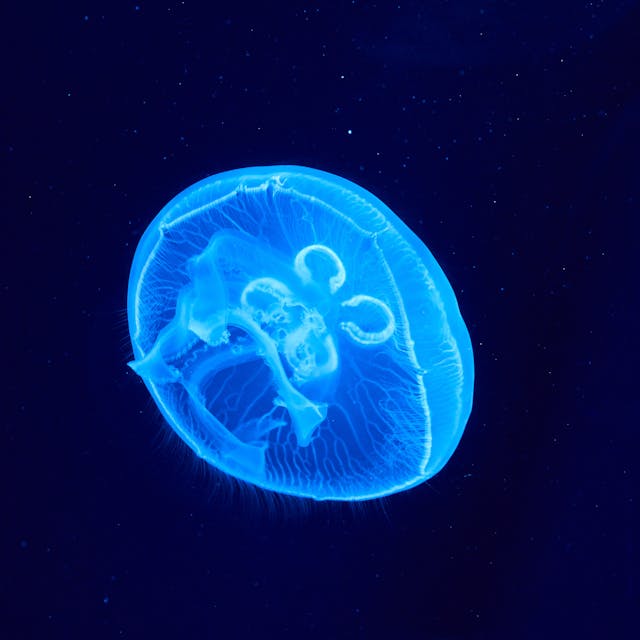
Why do some fish create their own light? Some fish create their own light to attract prey or, surprisingly, to hide from predators, and many other reasons as well.
Being able to create light is called bioluminescence and it is not limited to just fish. The most common organism that creates light on land is probably the firefly. They produce light to attract a mate. There are some fungi that can create light, as can some types of algae. However, there are far more creatures in the sea that can do this than there are on land. Scientists believe that over 80% of all the fish in the oceans are bioluminescent.
Nearly all of the fish in the sea that have bioluminescence tend to be very deep down. This is because light doesn’t travel very far down into the ocean. Sunlight can travel all through the atmosphere and reach the ground because air is not that dense. Once the sunlight hits the water and starts to travel into the ocean, it has a lot more trouble because water is very dense. The light molecules get scattered and light can only travel about 1,000 m into the water. Once you get below 1,000 m, the ocean is pretty dark. The only way fish can see or be seen is to create their own light.
There are generally five reasons why fish are bioluminescent. The first reason is to attract prey. A good example of this is the angler fish. The angler fish has a part of its dorsal fin that sticks out in front of its head and looks like a fishing rod (hence the fish’s name). At the end of the rod is a small bioluminescent organ called an esca. When the angler fish swims, this glowing organ bobs up and down, looking very much like food. Other fish and shrimp are attracted to the light and when they get close enough, the angler fish eats them.
The second reason is to hide from predators. This might sound slightly counterintuitive. Why would giving off light help a fish hide from a predator? Well, it all comes down to what color light they are giving off. Deep in the sea, there is no light, but looking up, there is a very dim light. It would be too dim for us to see, but the fish that live in the sea have better night vision than we do and they can detect much smaller amounts of light. Any dark fish swimming above a predator would stand out against this lighter background. To avoid that, a lot of fish use bioluminescence on their underside to give off a faint light that matches that coming down from the surface, thereby hiding.
The third reason is as a way to distract a predator. Some fish use their bioluminescence to hide, but some use it to be startling. When they are being attacked, or when they spot a predator, some fish can produce bright flashes that appear to move around their body. These lights and movements will startle a predator, as well as making the fish seem bigger than it actually is. Jellyfish do this. There is a sea worm called swima bombiviridis that can drop glowing bombs to distract the predator while it swims away. They are made of modified gill parts and they start to glow as soon as the worm has ejected them.
The fourth reason is to be able to see prey. There is no light from the sun at that depth, so some fish have to create their own light so they can see what they are hunting. Some fish at that depth have evolved to be able to see red and they create a red light to find their prey. This is very cunning. When sunlight hits the sea, the lower energy longer wavelengths, such as red, get absorbed much more quickly than the shorter more powerful wavelengths, such as blue. This means that there is no red light deep in the sea and most fish have evolved not to be able to see red because they don’t need it. Many fish have also evolved to be red so that they can’t be seen. The sneaky fish that have evolved to produce red light and be able to see red can catch these other fish.
The fifth reason is to find a mate. In the same way that birds use their colors and song to attract a mate, many fish in the sea use their bioluminescence to signal to a mate where they are and that they are ready. This is a tactic that is fraught with danger because the brighter animals have more chance of finding a mate, but they have a greater chance of being eaten as well.
There are generally two ways that fish create this bioluminescence. The first way is by using bacteria that produce light. The angler fish uses this method. The lure at the end of its fishing rod is covered with light producing bacteria. The second way is through chemical reactions within the fish. By using chemical reactions, the fish can switch the light on and off and they can make it move. And this is what I learned today.
Photo by Timo Volz: https://www.pexels.com/photo/blue-jellyfish-1771338/
Sources
https://www.u-tokyo.ac.jp/focus/en/features/z1304_00230.html
https://www.amnh.org/explore/ology/marine-biology/they-glow2
https://en.wikipedia.org/wiki/List_of_bioluminescent_organisms
https://www.webmd.com/a-to-z-guides/what-to-know-about-bioluminescent-algae
https://oceanexplorer.noaa.gov/facts/light-distributed.html
https://www.amnh.org/learn-teach/curriculum-collections/deep-sea-vents/light-and-dark-in-the-sea

Pingback: #976 What is the immortal jellyfish?
Pingback: #219 Why don't deep sea fish get crushed by the pressure?
Pingback: #500 How do fluorescent lights work?
Pingback: Why do peacocks have such long tails?
Pingback: #548 How do fireflies glow?
Pingback: #703 Is a starfish a fish?